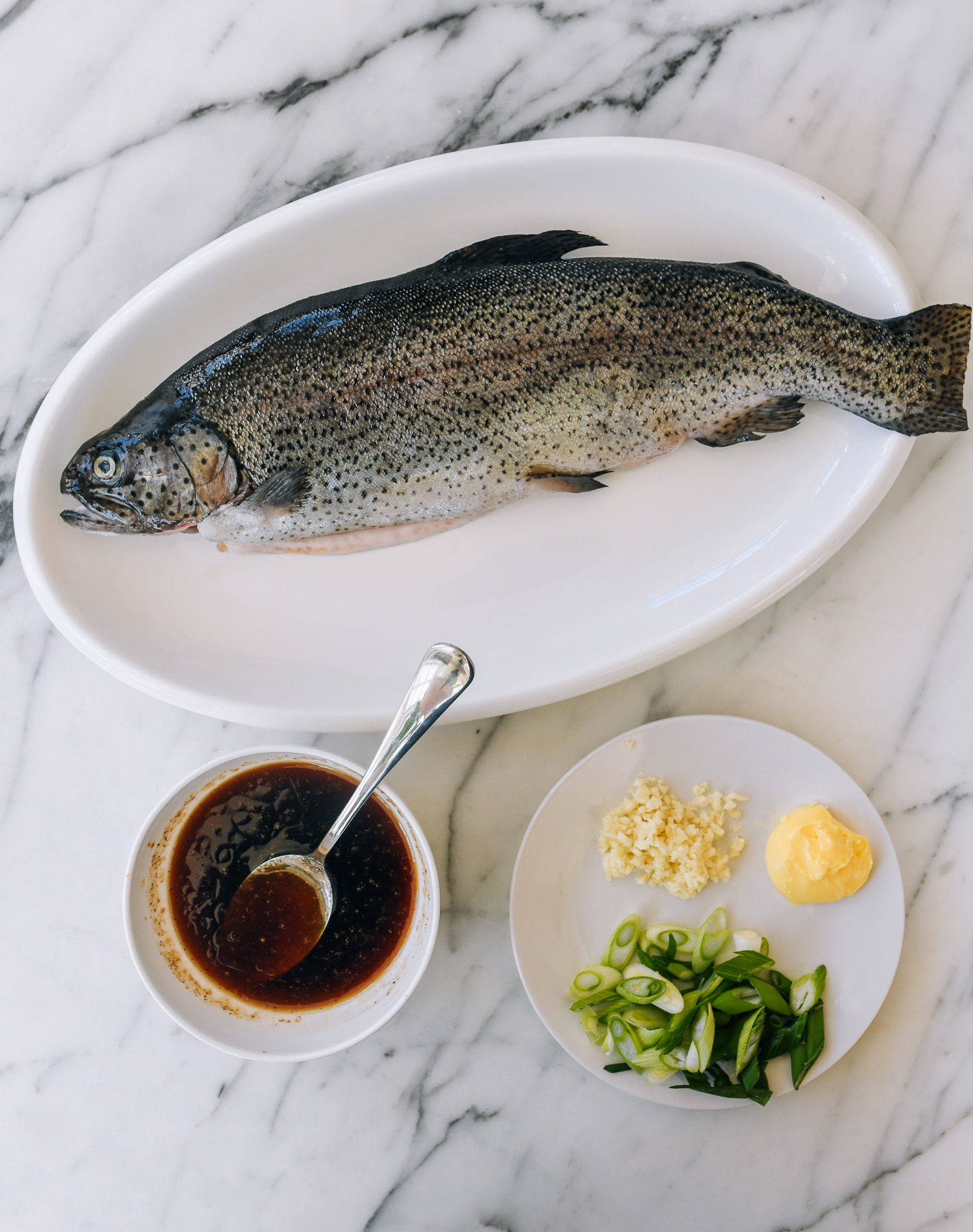Learn how to cook trout quickly and easily in a frying pan, with a delicious, rich sauce of garlic, butter, and soy sauce. All the flavors meld together in this exceptionally tasty trout recipe!
Cooking Different Types of Trout
Figuring out how to cook trout properly really depends on what type and size you’re working with.
Large, thick fillets of lake trout or steelhead, which are ocean-going rainbow trout a lot like salmon, reaching 15-20 pounds or even larger, call for one approach, while the smaller rainbow or brook trout caught in streams and rivers—usually 6 to 15 inches long—require another. Even farm-raised rainbow trout are typically harvested at around 15 inches (38cm) and 1 ½ pounds (680g), though you can also find them sold as smaller fillets.
For large trout, fillets make sense. Cooking a 10-pound fish whole just isn’t practical. These big fish get filleted and portioned like salmon. But for smaller trout (1 pound and under), I’ve always felt that filleting seems wasteful. The fish gave its life for your meal, so I believe in using as much of it as possible.
Trout Fishing Memories
My experience cooking trout goes back to childhood fishing trips where I grew up in the Catskills—up in Sullivan County, New York. While there’s world-class fly fishing throughout the region (The Catskills is considered the birthplace of American fly fishing!), as a kid, I stuck to smaller streams where I could fish from shore and hop along the rocks without needing waders.
My setup was simple: an ultralight pole rigged with 6-pound line, a small barbless hook, and a shot weight. With my creel slung around my neck to hold tackle, bait, and fish, I’d float a worm downstream into the holes where trout liked to hide.
And what a joy it would be when I felt that first bite—that little “doink doink” on the line that would get my adrenaline flowing in anticipation of catching that clever little brook trout.
I’d regularly catch native spotted brook trout between 6 and 9 inches, lifting them straight from the water into my creel. Anything close to 12 inches would have me fist-pumping and jumping around—that was trophy territory and an epic day!
Our Favorite Way to Cook Trout
After a good morning of fishing (meaning we caught enough trout to eat – 5 each was the limit), my friends and I would sometimes get together, make a small campfire, and fry up the day’s catch.
The first step would be to clean the trout by opening the belly from the bottom up to the gills and removing the gills and the insides. Then you run your fingernail along the length of the backbone inside the cavity to remove the dark bloodline, and that’s it! Brook trout do have small scales, but removing them is not really necessary. They are so small and even add to the crispy texture when pan-fried. And yes, we ate the skin.
Our go-to method was pan-frying in butter with garlic and salt until golden on both sides. One time, I brought a small bottle of soy sauce and some scallions to change things up a little. We added them to the garlic and butter, and just like that, a new recipe was born.
The combination of garlic, butter, soy sauce, and scallions created this incredible umami explosion. It perfectly complemented the fresh trout, and my friends loved it!
These days, I have less time for trout fishing. But I still make this dish regularly using farm-raised whole rainbow trout from the grocery store, typically 1 to 1 ½ pounds.
I hope you enjoy this pan-fried trout recipe and that it inspires you to try your hand at learning how to cook trout yourself!
Pan-fried Whole Trout Recipe Instructions
Mix the sauce in a bowl by combining the sugar, hot water, soy sauce, oyster sauce, wine, sesame oil and white pepper.
Use a paper towel to pat the fish dry on both sides, and rub the inside of the fish with a large pinch of salt.

Heat a carbon steel wok or large frying pan over medium-high heat until just smoking. Add the oil to coat.
Carefully lay the fish down and let it fry for 7 minutes on the first side. Don’t move the fish until it forms a crust and releases easily (around the 5-minute mark).
As it cooks, pick up the wok or pan and swirl the oil around the fish. This helps prevent certain areas of the fish from sticking, and also helps with even cooking. The pan should be hot and you should be hearing plenty of sizzling. That said, if you see too much smoking or risk of burning, reduce the heat as needed.

After 7 minutes, flip the fish over using a fish spatula (or use two spatulas at once—one to get underneath the fish, and the other to balance it.
Once again, don’t move it after you’ve flipped it. And this time, cover the pan. This essentially “bakes” the fish, or steams it, making


After 5 minutes, check on the fish. By then, it should easily release from the pan and slide around. Continue to cook for another 2 to 3 minutes until the inside cavity of the fish is opaque. You can use an instant-read thermometer to check that the internal temperature near the bone is 140°F/60°C. Cover again if it needs more time to cook.

Carefully transfer the fish to a plate. It will continue cooking and should reach 145°F/63°C as it rests. Cooking times will vary depending upon the size of your fish, so using a thermometer is more precise.
Tip Box!
If using trout fillets, cooking time will be reduced significantly. Heat a pan until just smoking and lay the fillet skin side down. Don’t move it and let it cook for 2 to 3 minutes until a crust forms. Carefully flip the fillets and sear on the other side for another 1 to 2 minutes.
Over medium heat in the same pan, add the garlic and white portions of the scallions. Cook for about 10 seconds and add the sauce mixture. Stir and bring to a simmer.
Reduce the sauce for about 1 minute, stirring constantly, and add the green parts of the scallion and the butter.



After the butter has melted and the sauce starts to simmer, pour the sauce over the fish.

Serve!

How to Cook Trout (with Garlic Soy Butter!)
Learn how to cook whole trout quickly in a frying pan, along with a delicious pan sauce of garlic, butter, and soy sauce.

serves: 2
Prep: 20 minutes
Cook: 20 minutes
Total: 40 minutes
Instructions
-
Mix the sauce in a bowl by adding the sugar, hot water, soy sauce, oyster sauce, wine, sesame oil and white pepper.
-
Use a paper towel to pat the fish dry on both sides, and rub the inside of the fish cavity with a large pinch of salt.
-
Heat a carbon steel wok or large frying pan over medium-high heat until just smoking and add the oil to coat. Carefully lay the fish down and let it fry for 7 minutes on the first side—don’t move the fish until it forms a crust and releases easily (around the 5-minute mark). Pick up the pan and swirl the oil around the fish. If using fillets, allow it to cook for 2-3 minutes until a crust forms.
-
After 7 minutes, flip the fish over using a fish spatula (or a couple spatulas!) Once again, don’t move it, and this time, cover the pan. After 5 minutes, check on the fish. By then, it should easily release from the pan and slide around. Continue to cook for another 2 to 3 minutes until the inside cavity of the fish is opaque. You can use an instant-read thermometer to check that the internal temperature near the bone is 140°F/60°C. Cover again if it needs more time to cook. If using fillets, all you need to do is sear the other side for 1-2 minutes.
-
Carefully transfer the fish to a plate. It will continue cooking and should reach 145°F/63°C as it rests. Cooking times will vary depending upon the size of your fish, so using a thermometer is more precise.
-
Over medium heat in the same pan, add the garlic and white portions of the scallions. Cook for about 10 seconds and add the sauce mixture. Stir and bring to a simmer.
-
Reduce the sauce for about 1 minute, stirring constantly, and add the green parts of the scallion and the butter. After the butter has melted and the sauce starts to simmer, turn off the heat and pour the sauce over the fish. Serve.
nutrition facts
Calories: 483kcal (24%) Carbohydrates: 5g (2%) Protein: 60g (120%) Fat: 23g (35%) Saturated Fat: 6g (30%) Polyunsaturated Fat: 6g Monounsaturated Fat: 9g Trans Fat: 0.3g Cholesterol: 182mg (61%) Sodium: 751mg (31%) Potassium: 1444mg (41%) Fiber: 0.4g (2%) Sugar: 2g (2%) Vitamin A: 411IU (8%) Vitamin C: 9mg (11%) Calcium: 210mg (21%) Iron: 2mg (11%)

